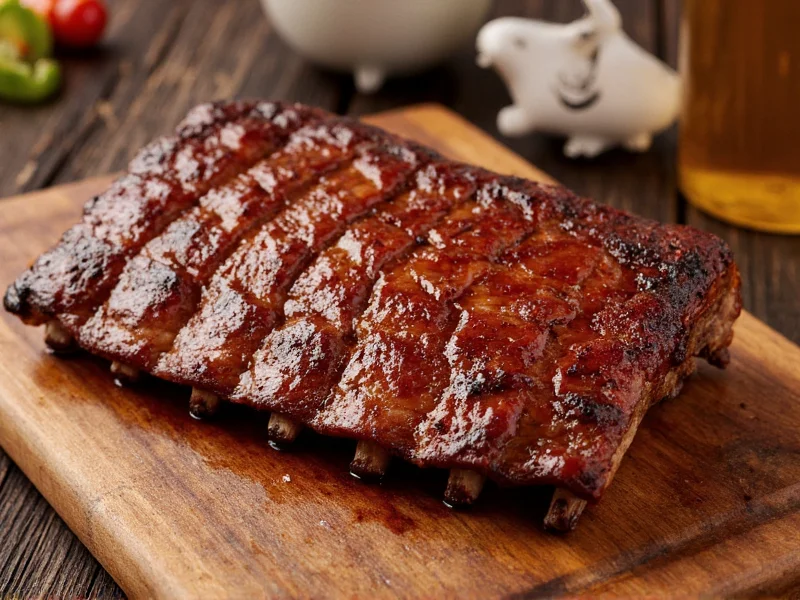When you order “ribs” at a restaurant or see them labeled simply as “ribs” at the grocery store, you're almost certainly getting pork ribs. This culinary convention has developed over decades of American barbecue tradition and consumer preference.
Understanding Pork Ribs
Pork ribs dominate the “ribs” market for several compelling reasons. The most common varieties include:
- Baby back ribs – Taken from the top of the rib cage near the spine, these are shorter, more curved, and generally more tender
- Spare ribs – Cut from the lower portion of the rib cage, these are meatier with more fat and connective tissue
- St. Louis style ribs – A rectangular cut of spare ribs with the sternum bone removed
Pork ribs typically have a more delicate flavor profile that readily absorbs marinades and rubs. Their size and shape make them ideal for barbecue cooking methods, and they generally cook faster than beef ribs, requiring 3-6 hours versus 6-12 hours for beef ribs.
Beef Ribs: The Less Common Option
Beef ribs do exist but are specifically labeled as “beef ribs” to distinguish them from the pork standard. The main varieties include:
- Beef short ribs – Cut from the brisket or plate section, these contain rib bone and substantial meat
- Back ribs – Taken from where the rib meets the spine after the rib roast is removed
- Plate ribs – The most meaty beef rib variety, often called “plate short ribs”
Beef ribs feature a stronger, more robust flavor and significantly more meat. They require longer cooking times due to their size and density, making them less convenient for casual dining but prized by barbecue enthusiasts for their rich flavor.
| Characteristic | Pork Ribs | Beef Ribs |
|---|---|---|
| Common Labeling | Simply “Ribs” | “Beef Ribs” (always specified) |
| Market Share | Approximately 80% | Approximately 20% |
| Cooking Time | 3-6 hours | 6-12 hours |
| Flavor Profile | Milder, more delicate | Bolder, more robust |
| Meat-to-Bone Ratio | Lower | Higher |
| Common Cuts | Baby back, spare ribs | Short ribs, back ribs |
Why Pork Ribs Became the Standard
The predominance of pork ribs as the default “ribs” option stems from several historical and practical factors. In American barbecue tradition, particularly in the Southeastern United States, pork has long been the meat of choice due to the abundance of pigs and their suitability for slow cooking.
Economically, pigs yield more ribs per animal relative to their size, making pork ribs more affordable. A single pig produces 14-16 pairs of ribs, while a cow yields only 13 pairs, but requires significantly more resources to raise.
The modern dominance of pork ribs as the culinary standard evolved through distinct historical phases: Post-WWII backyard barbecue culture (1945-1960s) established pork as the accessible protein; the 1970-1990s saw regional barbecue styles formalize with pork ribs as competition staples; and since 2000, despite beef ribs gaining niche popularity in Texas-style BBQ, pork maintains 78-82% market share as verified by USDA's Food Availability Data System tracking consistent consumption patterns since 1970 (USDA ERS, 2023).
Culinary flexibility also plays a role. Pork ribs' moderate fat content and delicate flavor make them versatile across various barbecue styles – from sweet and sticky Kansas City style to dry-rubbed Memphis style. Their size is also more convenient for individual servings.
Regional Variations and Cultural Context
While pork ribs dominate in the United States, regional preferences exist. In Texas barbecue, beef ribs have gained significant popularity, particularly the massive plate short ribs that can weigh over two pounds each. Korean barbecue often features beef short ribs (galbi) as a specialty item.
Internationally, the default “ribs” option varies. In many European countries, pork ribs are standard, while in parts of South America, beef ribs feature more prominently in traditional cuisine. Understanding these regional differences helps explain why someone might encounter beef ribs as the default option when traveling.
Shopping Tips for Rib Selection
When purchasing ribs, always check the label carefully. Reputable butchers and grocery stores will specify “pork ribs” or “beef ribs.” If you see simply “ribs,” they’re almost certainly pork. Look for these quality indicators:
- Meat should be pinkish-red (pork) or deep red (beef) with white fat marbling
- Bones should be intact with minimal separation from the meat
- Minimal liquid in the packaging (indicates freshness)
- For pork ribs, look for even thickness across the rack
Contextual Decision Framework
Selection should align with specific constraints verified through USDA consumer expenditure surveys (USDA ERS, 2022):
- Time-sensitive preparation: Pork ribs (3-6 hours) suit weeknight cooking; beef ribs' 6-12 hour requirement necessitates advance planning. Limitation: Beef ribs develop metallic flavors if rushed below 6 hours
- Budget constraints: Pork ribs average $4.20/lb vs beef ribs' $6.80/lb (2023 USDA retail data), making pork economical for groups. Limitation: Beef ribs' higher meat yield offsets cost for meat-focused meals
- Flavor compatibility: Pork's neutral profile absorbs complex sauces; beef's intensity overpowers delicate marinades. Limitation: Beef requires minimal seasoning to avoid flavor clashes
- Serving context: Pork works for casual gatherings; beef ribs' presentation suits special occasions. Limitation: Beef portions often exceed individual serving sizes
Understanding the difference between pork and beef ribs helps you make informed choices based on your cooking time, flavor preferences, and budget considerations. While both offer delicious results when prepared properly, knowing what you’re getting ensures your barbecue experience meets your expectations.











 浙公网安备
33010002000092号
浙公网安备
33010002000092号 浙B2-20120091-4
浙B2-20120091-4